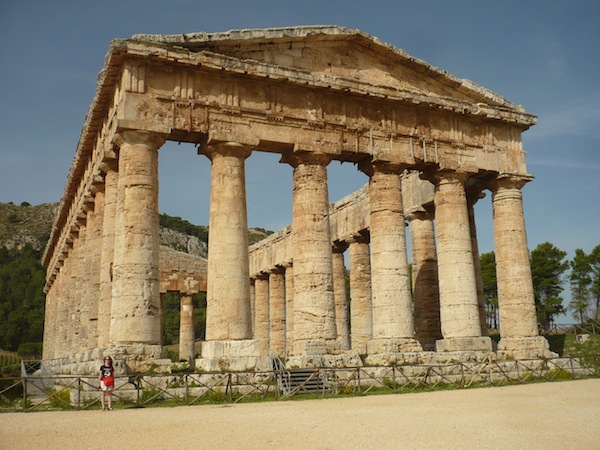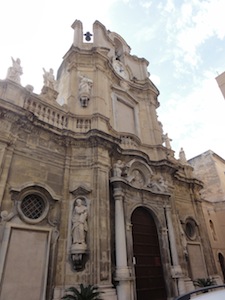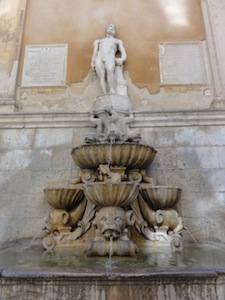For some time I’d wanted to visit the Mediterranean island nation of Malta. There is a scene in the World War II film Malta Story, starring Alec Guinness, in which his RAF pilot and the local girl he falls for visit some ancient stone ruins, and these intrigued me, looking as they did like no other ruins I’d ever come across. It turns out these ancient structures, created by a mysterious culture known as the “temple people,” are older than the Pyramids, older than Stonehenge – some 5,500 years old, in fact. That was it; I had to see them.
But how to travel to Malta? Big trip (from New York), small place – it didn’t seem to make sense to spend so much travel time to see just one fairly small destination and then come home. So we made it a two-week trip and spent the first week traveling around Sicily, the large southern Italian island that’s just a short ferry ride from Malta.
 An early morning connection in Germany took us on a flight south over the Alps, giving us some bonus scenery as we headed from chilly fall latitudes to a more summery zone. October turned out to be an ideal time to visit Sicily and Malta. We had warm weather but, in most places, relatively thin tourist crowds to deal with.
An early morning connection in Germany took us on a flight south over the Alps, giving us some bonus scenery as we headed from chilly fall latitudes to a more summery zone. October turned out to be an ideal time to visit Sicily and Malta. We had warm weather but, in most places, relatively thin tourist crowds to deal with.
The sun burned hot on the parking lot pavement as we waiting for our rental car at the Palermo airport. Although we hadn’t requested a high-end vehicle, we were issued an Audi. Later I was very glad for the well-built car as we traversed the mountains through hairpin turn after hairpin turn for what seemed like days (but was only hours) under the baleful gaze of Mount Etna. But that’s to come.
Although we hadn’t requested a high-end vehicle, we were issued an Audi. Later I was very glad for the well-built car as we traversed the mountains through hairpin turn after hairpin turn for what seemed like days (but was only hours) under the baleful gaze of Mount Etna. But that’s to come.
Our first destination was one of the loveliest hotels I’ve ever been to: Villa Cefala, an agriturismo on a working farm in a small town called Santa Flavia, east of Palermo along Sicily’s northern coast. For a few days we called this beautiful, sleepy place home. Lime trees, redolent night-blooming jasmine, and olive groves surrounded the buildings.

One morning I was slowly awakened by what sounded like a heavy trickle of water outside. Was it raining? A look out the window told me no. Was there a leak somewhere in the building? Again, no.

It turned out it wasn’t water at all, but the opposite: the crackling of fire. A farm worker was burning dead olive branches in a pit just a few meters outside our room. It had never occurred to me that fire and trickling water might sound very similar, but they can. One thing was sure: These are not sights you’re likely to see at a Holiday Inn.




We also had a wonderful meal at Villa Cefala’s restaurant, discovering what “antipasto” really means, in Sicily anyway: a seemingly endless procession of fantastic fresh seafood dishes, eggplant dishes, and more – before even getting to your main course. And this was lunch.
The verdict: two happy thumbs up for Villa Cefala.
Before exploring the big city nearby, we took a day trip to the historic towns of Trapani and Erice southwest of Palermo. On the way we stopped to see the great Greek temple at Segesta.

Segesta was an important city in ancient times and instrumental in inciting the disastrous attack on Sicily by the Athenian navy (disastrous for Athens) in 415-413 BC. The great Doric temple, which dates from around the same time, was apparently never finished. It’s huge, though.

We elected not to take the tourist bus to the nearby ruins of the city itself, since we had a lot on our schedule that day and, having seen plenty of Greek ruins in Greece, hadn’t made them our main reason to come to Sicily. (Nevertheless, Greek ruins aplenty were in our Sicilian-adventure future.)
So we said goodbye to the temple and the trees and the cacti on the slopes of Segesta, got back in the Audi, and continued to Trapani, whose old city crowds onto a small sickle-shaped peninsula on Sicily’s northwest coast. Trapani is full of beautiful old buildings, but it may say something about the state of our stomachs when we arrived that the first picture my wife took was a display of marzipan.
We walked around the old city, some of them pedestrian-only (in practicality if not in law), and ate lunch at an outdoor cafe right near the tourist office. Most of the historic sights in Trapani are churches and church-related buildings. It makes you realize how dominant a social force the Church was in these places in those times.
and ate lunch at an outdoor cafe right near the tourist office. Most of the historic sights in Trapani are churches and church-related buildings. It makes you realize how dominant a social force the Church was in these places in those times.
 I can’t quite make out from the inscription which King Ferdinand this is. Ferdinand I of the Two Sicilies? In any case the date is 1778. The city is positively festooned with reliefs, inscriptions, artwork of all kinds. But Trapani is still a fishing port. I was particularly taken by this statue of Venus by the fishmarket square.
I can’t quite make out from the inscription which King Ferdinand this is. Ferdinand I of the Two Sicilies? In any case the date is 1778. The city is positively festooned with reliefs, inscriptions, artwork of all kinds. But Trapani is still a fishing port. I was particularly taken by this statue of Venus by the fishmarket square.
It was a beautiful day and we spent most of our time in Trapani just walking the streets.
The fact is, we were anxious to get to nearby Erice with plenty of daylight left. So we parked our car at the cable car station and took the long, spectacular funivia ride up the mountain to the ancient city.
To be continued in Part 2.
 Blogcritics The critical lens on today's culture & entertainment
Blogcritics The critical lens on today's culture & entertainment









Sicily! How wonderful! I’ve been in love with it since I saw “Seduced and Abandoned” a hundred years ago, or thereabouts. Oddly, I’ve never actually been there. So I have to get booster shots from the incomparable “Montalbano” TV series.